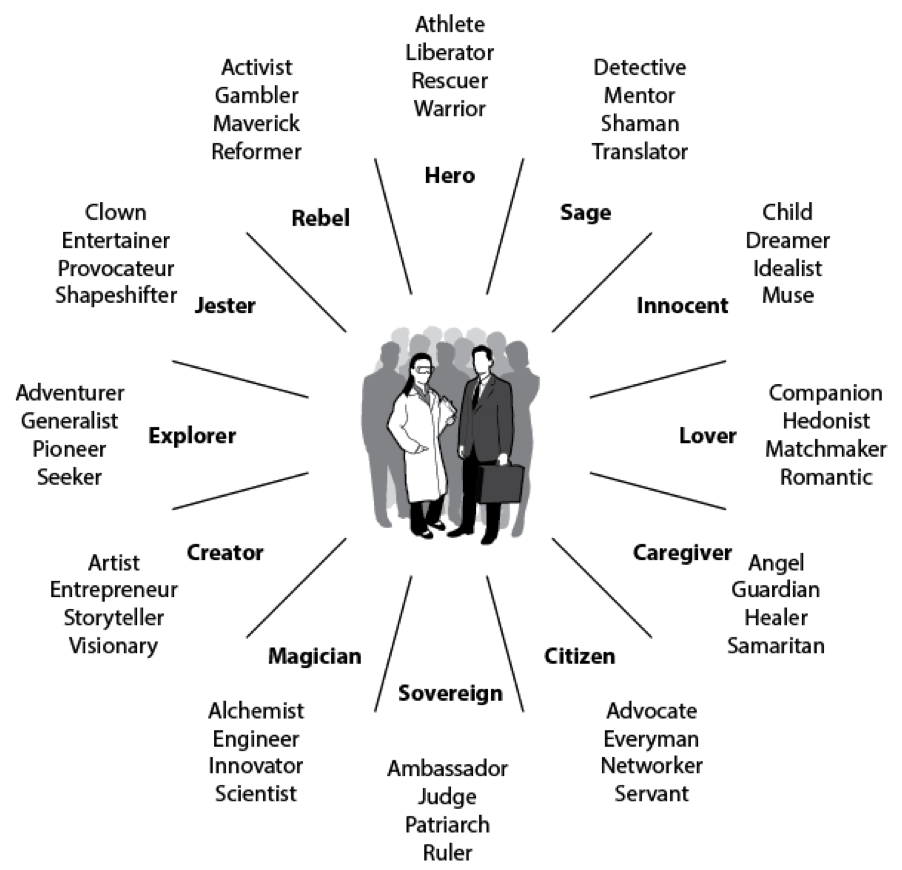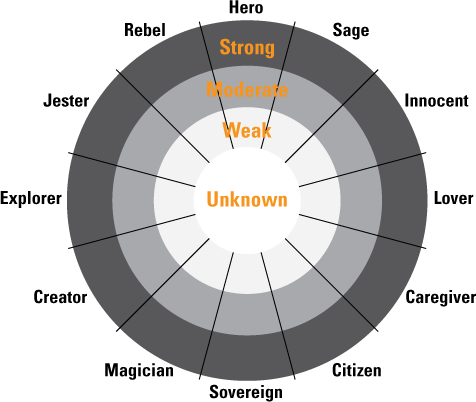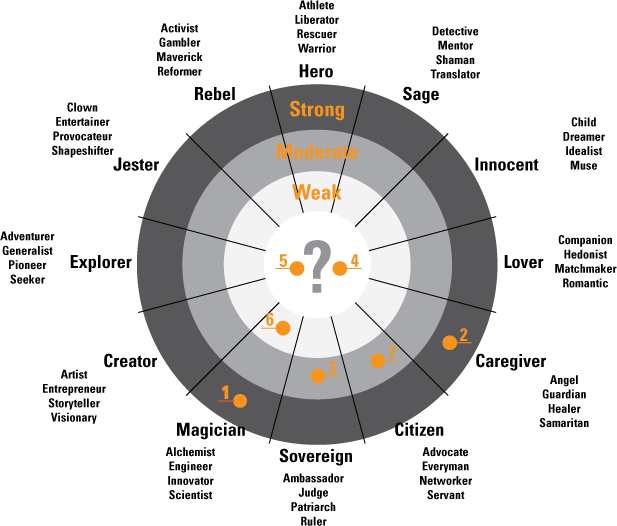Archetypes in action in life science marketing
By David Chapin
SUMMARY
VOLUME 6
, NUMER 4
Archetypes are one effective way for life science companies to create greater differentiation and pricing power through effective marketing. In this issue, I’ll explore an example of bringing archetypes to life throughout your marketing communications, and I’ll discuss how you can determine the archetypes of your competition.
Archetypes and meaning in life science marketing
In our last issue I introduced 12 different categories of archetypes that can be used in marketing, as shown in figure 1. I defined some characteristics for each of the basic archetypes, and examined why you shouldn’t choose the Scientist or the Innovator archetype.
What gives archetypes their power? Remember that archetypes are patterns – patterns that your audiences recognize. Even if you only show them part of the pattern, your audience will tend to complete the pattern by themselves. This enables archetypes to act as a “shorthand” – they assist your audiences in assigning meaning to your brand and marketing communications. This meaning helps clarify and distill your marketing voice.
Figure 1. There are many different possible archetypes that you can use in life science marketing. A few are shown here.
Why are archetypes useful? Once Forma’s clients have been trained in the use of archetypes to guide their marketing, they prove to be more consistent in their marketing voice and their marketing decisions. Consistency is one of the most important factors in creating a clear and unique position in the minds of the audience. In fact, one of the earliest symptoms of marketing communication failure is a lack of consistency; the communications “wander,” sometimes expressing this position, sometimes that position. Nothing could be more confusing to your audiences, and therefore more damaging to your attempt to influence the image of your organization. Archetypes, when properly used, can be a powerful way to manage and maintain the “meaning” and consistency of your brand.
Archetypes in action in life science marketing
Archetypes can show up in many ways, both big and small. In the last issue, I provided an example of Nike® using the Hero archetype, in an ad showing a soccer player who had been immortalized as a statue.
I made the point that by using the archetype of the Hero, Nike was encouraging the audience to ascribe the attributes of a hero to Nike, namely: courage, strength, skill, willingness to tackle long odds, etc. And by extension, these attributes transfer to Nike’s products and to the users of those products.
Ads require that all communication be condensed; they (ideally) are trying to impress a single point on the audience. Ads are a perfect place to employ archetypes, because archetypes, – which enable the audience to complete a partial pattern – condense lots of meaning into a small space. So archetypes typically will show up very clearly when they are used in ads.
But the importance of traditional advertising is diminishing, rapidly. So are archetypes useful elsewhere in marketing?
Let’s look at a more practical, and in some ways more mundane example, one that’s closer to the life sciences. Imagine that your customers can use your product or service to review the results of some experiment or assay. Let’s further imagine that you have a set of frequently asked questions (FAQs) on your web site, related to interpreting the data that comes from this experiment or assay. I’m going to demonstrate how archetypes could show up in something that is very far down in the messaging hierarchy.
Let’s look at three sample paragraphs, each intended to introduce the collection of FAQs. As you read them, see if you can spot the differences.
| A We’re dedicated to delivering results in the most efficient way possible. And to do so, we’ve analyzed common interpretation challenges and compiled a list of effective fixes in these FAQs. If you don’t find the answers you need right here, email us at Joe@xyz.com or call us at 000-123-4567. We want to help you explore the deepest questions hidden in your data. |
B If you’re having trouble interpreting your results, we’ve put together these FAQs to help you find the perfect solution (so you can get back to your true love – putting this data to work). If you don’t find the answers you need right here, email us at Joe@xyz.com or call us at 000-123-4567. Chances are, we’ve seen your issue before, so we’ll help you find the right fit quickly. |
C Our experience shows that properly interpreting results can be problematic. We offer three ways to guide you to the most efficient solution. If you don’t find the answers you need right here in these FAQs, email us at Joe@xyz.com or call us at 000-123-4567. With our experience, we’ll have you back on the right path in no time. |
The paragraphs sound different don’t they? That’s because they embody different archetypes. One was written as a Sage, one as a Scientist and one as a Matchmaker. Can you tell which is which? As you read these three paragraphs, you’ll notice some of the words that distinguish each option, summarized in this table:
| A | B | C | |
| Key words from the paragraph | …delivering results in the most efficient way possible… …analyzed common interpretation challenges… …help you explore the deepest questions hidden in your data… |
…we’re here to help you find the perfect solution… …so you can get back to your true love… … we’ll help you find the right fit quickly… |
…properly interpreting results can be problematic… …three ways to guide you to the most efficient solution… With our experience, we’ll have you back on the right path in no time. |
| The feeling you get from these words | Logical and efficient | Concerned with you and the right fit | Experienced and guiding |
The personality that comes across from Paragraph A is concerned with logic and efficiency; it embodies the Scientist archetype. The personality that comes across from Paragraph B is concerned with the right fit, embodying the Matchmaker archetype. And the personality that comes across from Paragraph C is concerned with experience and guidance. Paragraph C embodies the Sage archetype.
The basic meaning of each of the paragraphs is the same. But the differences between them are not insignificant – especially not to someone who was having trouble interpreting the results of our (hypothetical) assay. If they’re reading FAQs, they’re most likely stuck and trying to get past a particular hurdle. So they’re looking for help. And the personality of the person they get help from can play a large role in how they feel about the entire organization. (If you have trouble understanding that last statement, think about that time you had an issue with your cell phone bill and called to speak to a representative. Their personality made all the difference.)
I’ve demonstrated how an archetype can be embodied in a very short, seemingly “messaging immune” paragraph. Now imagine that a consistent archetype was embodied, not only in this introductory paragraph, but throughout every question and answer in the entire set of FAQs. And not only in the section of FAQs, but in every section of the web site. This personality (the Scientist, the Matchmaker or the Sage) would then come through to the audience very clearly.
Now imagine that the archetype showed up everywhere else in this organization’s marketing communications – from a tradeshow booth to a sales presentation, from a downloadable e-book to a video. This is the kind of consistency that drives the creation of a clear image in the minds of the audience (for more on positions and the resulting images, see the Marketing Mechanism of Action).
The use of archetypes in life science marketing
Archetypes don’t just appear in written text. As in the Nike ad, they can show up in imagery as well. And so it should not surprise you to learn that archetypes can appear in all marketing touchpoints, all along the ladder of lead generation.
For example, archetypes can influence the choice of trade show giveaways. A life science company with a Jester archetype might give away a toy, while one with a Sage archetype might offer a piece of reference material (e.g., a poster detailing G-protein-coupled signaling pathways).
As another example, consider an organization that wants to attract attention from its audience and from the press by giving away some money. An organization with the archetype of the Jester might use a contest to determine the winner, attract attention, emphasize the fun that the contest provides, and use the money as prizes. In contrast, an organization with the archetype of the Citizen might use the money to fund scholarships, and emphasize the commitment being made to a particular discipline or to the good of society as a whole.
As these examples show, archetypes can – and should – influence all sorts of marketing decisions. Once you’ve settled on an archetype—for example, the Explorer—it can be helpful to use this archetype as a touchstone for all marketing decisions by asking: “What would the Explorer do?”
Examples of archetypes in life science marketing
For years, Quintiles has used the tagline: Navigating the New Health™. On their website, they state (as of this writing): “…we help biopharmaceutical and health sciences customers navigate the increasingly complex landscape with more predictability to enable better outcomes.” While one can’t reliably determine an archetype from a simple sentence or tagline, this tagline is suggestive of an archetype from the Sage family. This archetype would be useful for Quintiles, as Sages are seen as knowledgeable and uniquely positioned to offer guidance.
Given Quintiles’ position in the marketplace (the world’s largest CRO) another viable archetype for Quintiles could come from the Sovereign family, such as the Ruler or Patriarch. This archetype would set up Quintiles as the “gold standard” in clinical trials. The choice between the Sage and the Ruler would depend in part on the specific audiences that Quintiles was trying to influence.
These two archetypes, the Sage and the Ruler, would have very different marketing profiles. Since a Sage is a guide or a teacher, an organization expressing the Sage archetype would need to offer significant thought leadership and content on their website to be true to this archetype. And in fact, Quintiles does offer extensive webinars and white papers on their website. Does this content express an attitude of “this is the way it is” (a Ruler archetype) or “let us educate you about the intricacies of drug development” (a Sage archetype)? I’ll leave this to the reader to determine.
It is worth noting that the tagline Navigating the New Health no longer appears prominently on Quintiles’ web site. However, that tagline provides a clearer example for this analysis than the current headline on the home page: “Improve your probability of success.” In any event, it is worth repeating: one can’t reliably determine an archetype from a single sentence or tagline.
Determining the archetypes of your competitors in life science marketing
Now that you’re aware of archetypes, you may start noticing them all over – even in your competitors’ marketing. It’s hard to precisely pinpoint the archetype of any organization when looking in from the outside, just as it is hard to determine an organization’s precise position. But it is possible to identify the clues they leave in public and use these to assemble a more complete picture – and come up with a very educated guess about the archetypes they’ve chosen (consciously or not).
Where should you start? It can take some practice to be able to identify specific archetypes correctly. Look for public-facing messages (on their website and in their brochures, for instance) that are distinct from the common language in your sector. For example, in a sector that is full of language such as, “We are a global manufacturer who is committed to producing a quality product,” a competitor who throws in a sentence like, “While we provide a product, what we really do is protect your brand,” would definitely stand out. This sentence might indicate a Guardian or Rescuer archetype.
But a single sentence only gives you one data point, and we all know that a “one-rat study” provides limited value. You can’t identify an archetype from a single sentence, or from a single image. Archetypes, when used properly (that is, consistently), permeate all aspects of an organization’s marketing, so if a competitor is using an archetype on purpose, clues that all point in a single direction should be available from many different touchpoints.
As you look across your complete set of competitors, most likely what you’ll find will be a mix. While some competitors will have obvious archetypes, the use of archetypes in life science marketing is still nascent, so you’ll probably find many competitors whose archetype is either obscure or impossible to determine. And since your goal is to own a distinctive position in the marketplace, that’s a good thing: the lack of strong competitive archetypes opens up a wider range of options for you to choose from.
Plotting your competitor’s archetypes in life science marketing
It is useful to record your competitors’ archetypes by plotting them, as in the following example. This diagram plots two attributes of each competitor’s archetype on a single diagram (using a polar coordinate system — for those of you who remember such things). The twelve different families of archetypes are organized in a circle, and the distance from the center of the diagram shows the strength and clarity of each organization’s archetypal expression — competitors that express their archetypes strongly are plotted farther away from the center and competitors that express their archetypes less clearly are plotted closer to the center.
Figure 2. Plotting competitors’ archetypes is a useful first step towards selecting your own archetype. Competitors with strong archetypal expression are plotted towards the outside of the diagram; those with weak or uncertain archetypal expression are plotted towards the center.
In Figure 3, competitors 1 and 6 both reveal evidence of the Scientist archetype (part of the Magician family), so they are plotted in the Magician’s sector. Competitor 1 reveals this archetype very strongly and so is plotted farthest from the center of the diagram, while competitor 6 reveals this archetype only weakly and so is plotted closest to the center of the diagram.
Competitors 4 and 5 reveal no clear archetype, so they are plotted in the center circle. Competitor 2 reveals a strong Caregiver while Competitor 3 reveals a moderate Ruler, and competitor 7 reveals a moderate Servant (part of the Citizen family).
This plot is useful, as it reveals archetypes that would face little or no competition. The competition in figure 3 is focused on the lower right hand quadrant, so a selection from any other quadrant would help distance your organization from the competition.
With your competition plotted, you are ready to pick your own archetype. I’ll cover this in detail in the next issue.
Summary
Archetypes are useful in bringing differentiation in position and consistency of message to your life science marketing efforts. In this issue I pointed out how the simplest passages of text on your web site can embody an archetype. I also revealed ways you might determine the archetypes of your competition. All this provides a foundation for picking your own archetype, which I’ll cover in detail in the next issue.
The Marketing of Science is published by Forma Life Science Marketing approximately ten times per year. To subscribe to this free publication, email us at info@formalifesciencemarketing.com.
David Chapin is author of the book “The Marketing of Science: Making the Complex Compelling,” available now from Rockbench Press and on Amazon. He was named Best Consultant in the inaugural 2013 BDO Triangle Life Science Awards. David serves on the board of NCBio.
David has a Bachelor’s degree in Physics from Swarthmore College and a Master’s degree in Design from NC State University. He is the named inventor on more than forty patents in the US and abroad. His work has been recognized by AIGA, and featured in publications such as the Harvard Business Review, ID magazine, Print magazine, Design News magazine and Medical Marketing and Media. David has authored articles published by Life Science Leader, Impact, and PharmaExec magazines and MedAd News. He has taught at the Kenan-Flagler Business School at UNC-Chapel Hill and at the College of Design at NC State University. He has lectured and presented to numerous groups about various topics in marketing.
Forma Life Science Marketing is a leading marketing firm for life science, companies. Forma works with life science organizations to increase marketing effectiveness and drive revenue, differentiate organizations, focus their messages and align their employee teams. Forma distills and communicates complex messages into compelling communications; we make the complex compelling.
© 2024 Forma Life Science Marketing, Inc. All rights reserved. No part of this document may be reproduced or transmitted without obtaining written permission from Forma Life Science Marketing.



